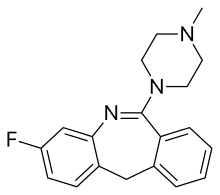Fluperlapine
Fluperlapine (NB 106-689), also known as fluoroperlapine, is a morphanthridine (11H-dibenzo[b,e]azepine ) atypical antipsychotic with additional antidepressant and sedative effects. It was first synthesized in 1979, and then subsequently studied in animals and humans in 1984 and beyond,[1] but despite demonstrating efficacy in the treatment of a variety of medical conditions including schizophrenia,[2][3][4][5] psychosis associated with Parkinson's disease,[6] depressive symptoms, and dystonia,[7] it was never marketed.[1] This was perhaps due to its capacity for producing potentially life-threatening agranulocytosis, similarly to clozapine,[8] which it closely resembles both structurally and pharmacologically.
 | |
| Clinical data | |
|---|---|
| ATC code |
|
| Identifiers | |
IUPAC name
| |
| CAS Number | |
| PubChem CID | |
| ChemSpider |
|
| UNII | |
| ChEMBL | |
| CompTox Dashboard (EPA) | |
| Chemical and physical data | |
| Formula | C19H20FN3 |
| Molar mass | 309.381 g/mol g·mol−1 |
| 3D model (JSmol) | |
SMILES
| |
InChI
| |
| | |
Pharmacology
Binding profile[9]
| Receptor | Ki (nM) |
|---|---|
| 5-HT2A | 7.9 |
| 5-HT2C | 18.2 |
| 5-HT6 | 29 |
| 5-HT7 | 4.6 |
| M1 | 8.8 |
| M2 | 71 |
| M3 | 41 |
| M4 | 14 |
| M5 | 17 |
| D1 | 85 |
| D2 | 316.2 |
| D3 | 254.7 |
| D4 | 21 |
References
- Ganellin, C. R.; Triggle, D. J.; Macdonald, F. (1997). Dictionary of pharmacological agents. CRC Press. p. 916. ISBN 978-0-412-46630-4. Retrieved 15 September 2011.
- Fischer-Cornelssen, K. A. (1984). "Fluperlapine in 104 schizophrenic patients. Open multicenter trial". Arzneimittel-Forschung. 34 (1A): 125–130. PMID 6145428.
- Woggon, B.; Angst, J.; Bartels, M.; Heinrich, K.; Hippius, H.; Koukkou, M.; Krebs, E.; Küfferle, B.; Müller-Oerlinghausen, B.; Pöldinger, W.; rÜTher, E.; Schied, H. W. (1984). "Antipsychotic efficacy of fluperlapine. An open multicenter trial". Neuropsychobiology. 11 (2): 116–120. doi:10.1159/000118064. PMID 6148712.
- Dieterle, D.; Eben, E.; Einhäupl, K.; Hippius, H.; Klein, H.; Rüther, E.; Schmauß, M. (2008). "The Effect of Fluperlapine in Acute Psychotic Patients". Pharmacopsychiatry. 17 (2): 57–60. doi:10.1055/s-2007-1017408. PMID 6728910.
- Woggon, B.; Heinrich, K.; Küfferle, B.; Müller-Oerlinghausen, B.; Pöldinger, W.; Rüther, E.; Schied, H. W. (1984). "Results of a multicenter AMDP study with fluperlapine in schizophrenic patients". Arzneimittel-Forschung. 34 (1A): 122–124. PMID 6145427.
- Scholz, E.; Dichgans, J. (1985). "Treatment of drug-induced exogenous psychosis in parkinsonism with clozapine and fluperlapine". European Archives of Psychiatry and Neurological Sciences. 235 (1): 60–64. doi:10.1007/bf00380972. PMID 2864254.
- Pakkenberg, H.; Pedersen, B. (1985). "Medical treatment of dystonia". Psychopharmacology. Supplementum. Psychopharmacology Supplementum. 2: 111–117. doi:10.1007/978-3-642-70140-5_14. ISBN 978-3-642-70142-9. ISSN 0179-8456. OCLC 10642795. PMID 2860654.
- Lai, W. G.; Gardner, I.; Zahid, N.; Uetrecht, J. P. (2000). "Bioactivation and covalent binding of hydroxyfluperlapine in human neutrophils: Implications for fluperlapine-induced agranulocytosis". Drug Metabolism and Disposition. 28 (3): 255–263. PMID 10681368.
- Roth, BL; Driscol, J (12 January 2011). "PDSP Ki Database". Psychoactive Drug Screening Program (PDSP). University of North Carolina at Chapel Hill and the United States National Institute of Mental Health. Archived from the original on 8 November 2013. Retrieved 3 December 2013.
| Typical |
|
|---|---|
| Disputed | |
| Atypical |
|
| Others | |
| |
| Classes |
|
|---|---|
| Antidepressants (TCAs and TeCAs) |
|
| Antihistamines |
|
| Antipsychotics |
|
| Anticonvulsants | |
| Others |
|
This article is issued from
Wikipedia.
The text is licensed under Creative
Commons - Attribution - Sharealike.
Additional terms may apply for the media files.